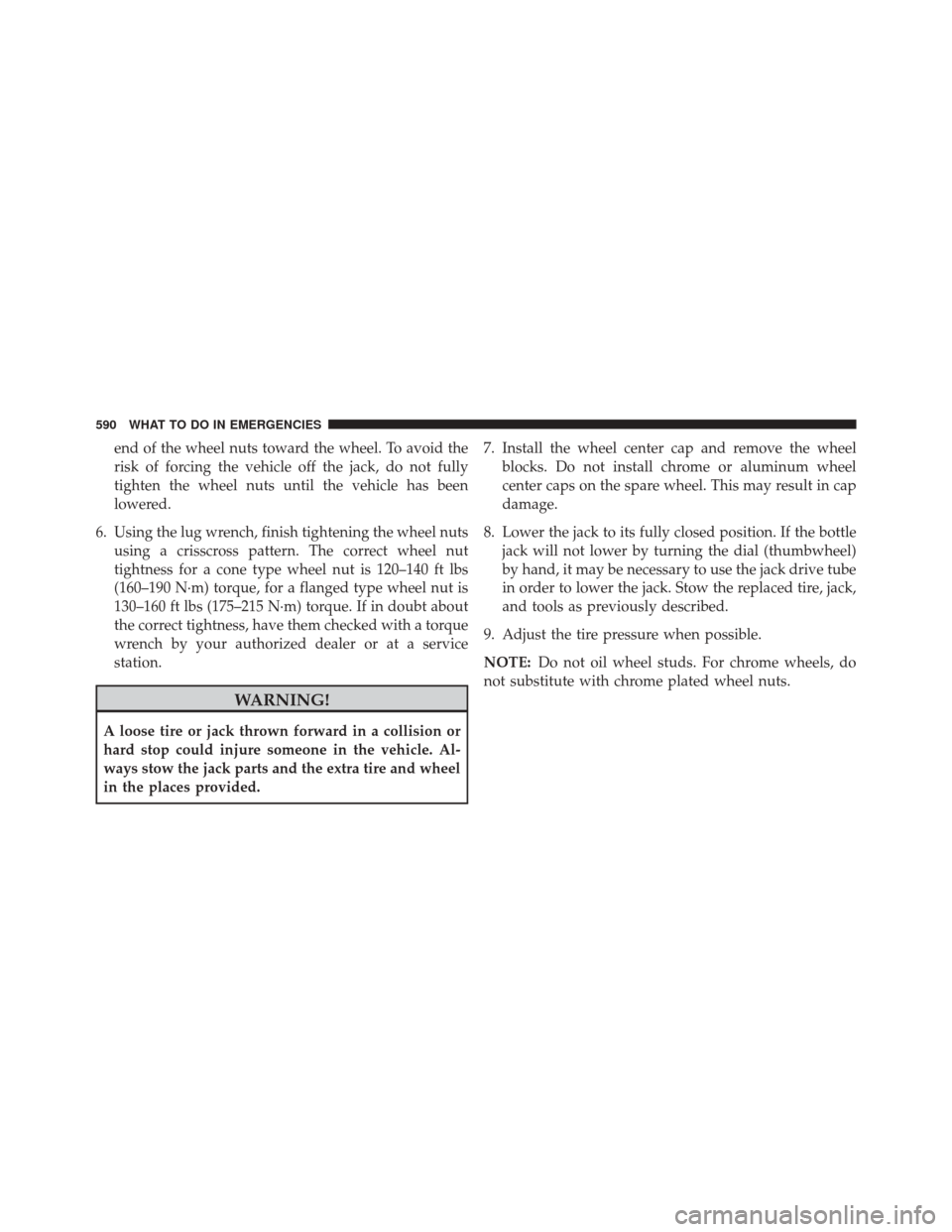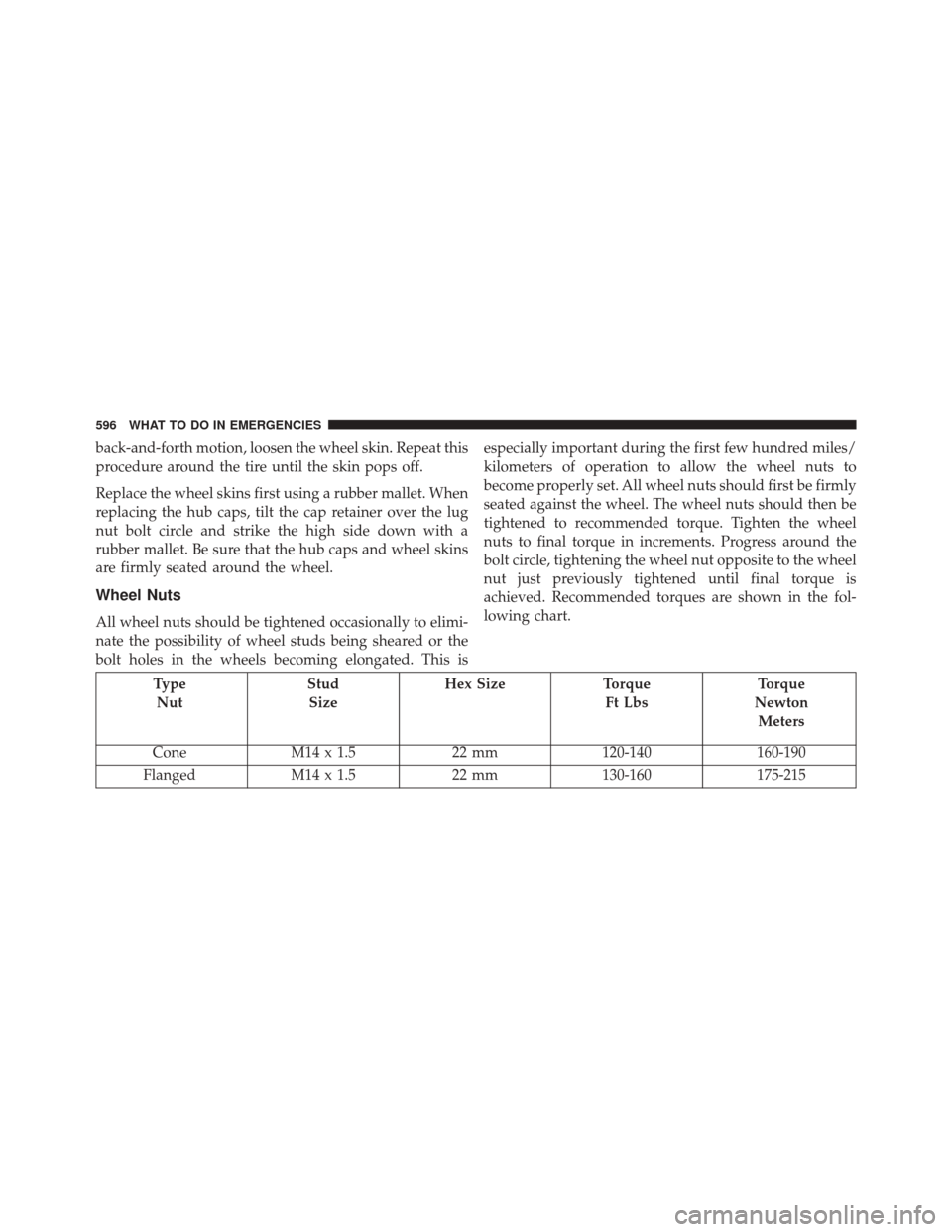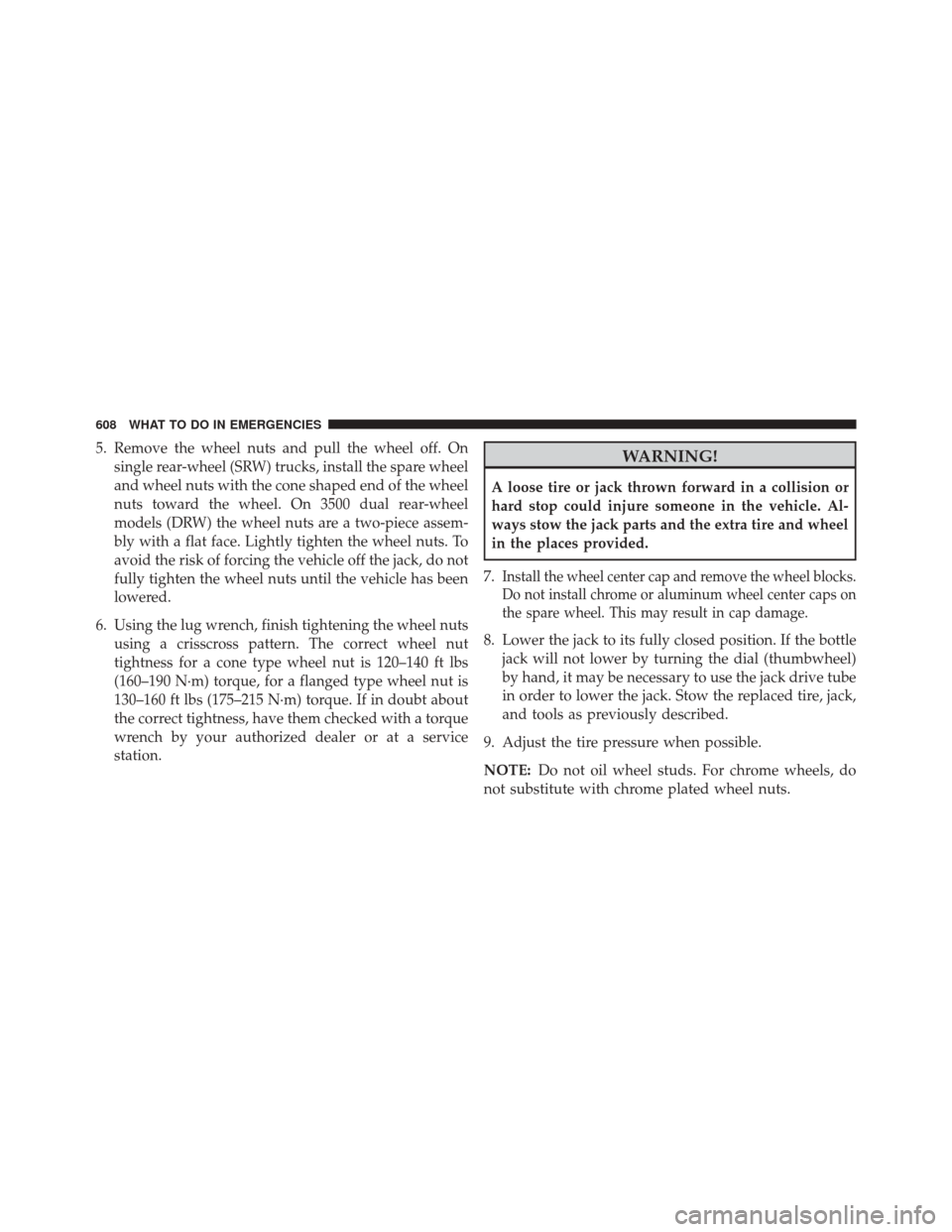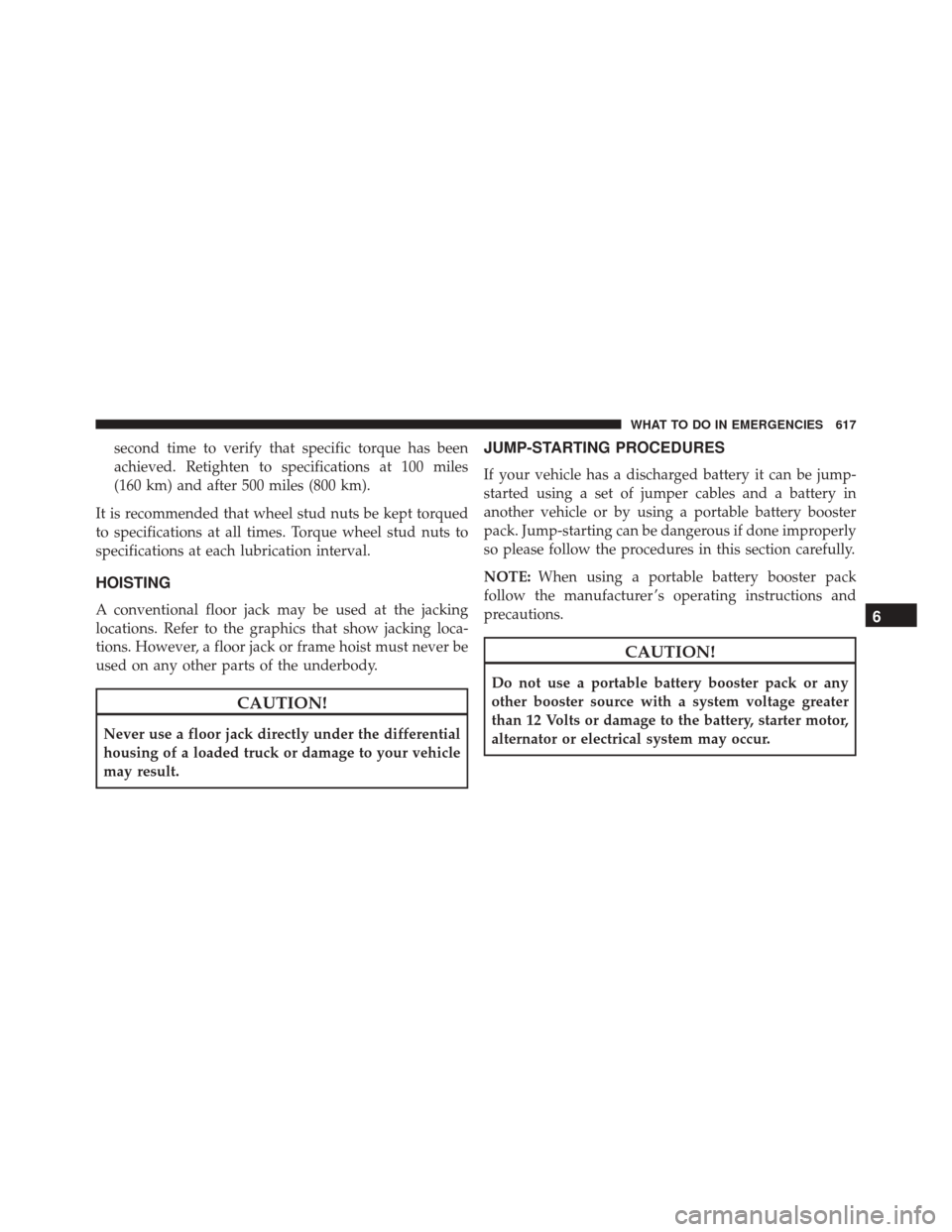torque Ram 2500 2013 Owner's Guide
[x] Cancel search | Manufacturer: RAM, Model Year: 2013, Model line: 2500, Model: Ram 2500 2013Pages: 743, PDF Size: 5.43 MB
Page 592 of 743

end of the wheel nuts toward the wheel. To avoid the
risk of forcing the vehicle off the jack, do not fully
tighten the wheel nuts until the vehicle has been
lowered.
6. Using the lug wrench, finish tightening the wheel nuts using a crisscross pattern. The correct wheel nut
tightness for a cone type wheel nut is 120–140 ft lbs
(160–190 N·m) torque, for a flanged type wheel nut is
130–160 ft lbs (175–215 N·m) torque. If in doubt about
the correct tightness, have them checked with a torque
wrench by your authorized dealer or at a service
station.
WARNING!
A loose tire or jack thrown forward in a collision or
hard stop could injure someone in the vehicle. Al-
ways stow the jack parts and the extra tire and wheel
in the places provided. 7. Install the wheel center cap and remove the wheel
blocks. Do not install chrome or aluminum wheel
center caps on the spare wheel. This may result in cap
damage.
8. Lower the jack to its fully closed position. If the bottle jack will not lower by turning the dial (thumbwheel)
by hand, it may be necessary to use the jack drive tube
in order to lower the jack. Stow the replaced tire, jack,
and tools as previously described.
9. Adjust the tire pressure when possible.
NOTE: Do not oil wheel studs. For chrome wheels, do
not substitute with chrome plated wheel nuts.
590 WHAT TO DO IN EMERGENCIES
Page 598 of 743

back-and-forth motion, loosen the wheel skin. Repeat this
procedure around the tire until the skin pops off.
Replace the wheel skins first using a rubber mallet. When
replacing the hub caps, tilt the cap retainer over the lug
nut bolt circle and strike the high side down with a
rubber mallet. Be sure that the hub caps and wheel skins
are firmly seated around the wheel.
Wheel Nuts
All wheel nuts should be tightened occasionally to elimi-
nate the possibility of wheel studs being sheared or the
bolt holes in the wheels becoming elongated. This isespecially important during the first few hundred miles/
kilometers of operation to allow the wheel nuts to
become properly set. All wheel nuts should first be firmly
seated against the wheel. The wheel nuts should then be
tightened to recommended torque. Tighten the wheel
nuts to final torque in increments. Progress around the
bolt circle, tightening the wheel nut opposite to the wheel
nut just previously tightened until final torque is
achieved. Recommended torques are shown in the fol-
lowing chart.
Type
Nut Stud
Size Hex Size Torque
Ft LbsTorque
Newton Meters
Cone M14 x 1.5 22 mm120-140 160-190
Flanged M14 x 1.5 22 mm130-160 175-215
596 WHAT TO DO IN EMERGENCIES
Page 610 of 743

5. Remove the wheel nuts and pull the wheel off. Onsingle rear-wheel (SRW) trucks, install the spare wheel
and wheel nuts with the cone shaped end of the wheel
nuts toward the wheel. On 3500 dual rear-wheel
models (DRW) the wheel nuts are a two-piece assem-
bly with a flat face. Lightly tighten the wheel nuts. To
avoid the risk of forcing the vehicle off the jack, do not
fully tighten the wheel nuts until the vehicle has been
lowered.
6. Using the lug wrench, finish tightening the wheel nuts using a crisscross pattern. The correct wheel nut
tightness for a cone type wheel nut is 120–140 ft lbs
(160–190 N·m) torque, for a flanged type wheel nut is
130–160 ft lbs (175–215 N·m) torque. If in doubt about
the correct tightness, have them checked with a torque
wrench by your authorized dealer or at a service
station.WARNING!
A loose tire or jack thrown forward in a collision or
hard stop could injure someone in the vehicle. Al-
ways stow the jack parts and the extra tire and wheel
in the places provided.
7.
Install the wheel center cap and remove the wheel blocks.
Do not install chrome or aluminum wheel center caps on
the spare wheel. This may result in cap damage.
8. Lower the jack to its fully closed position. If the bottle jack will not lower by turning the dial (thumbwheel)
by hand, it may be necessary to use the jack drive tube
in order to lower the jack. Stow the replaced tire, jack,
and tools as previously described.
9. Adjust the tire pressure when possible.
NOTE: Do not oil wheel studs. For chrome wheels, do
not substitute with chrome plated wheel nuts.
608 WHAT TO DO IN EMERGENCIES
Page 616 of 743

models use the blade on the end of the lug wrench to pry
the caps off. The wheel skin can now be removed.
CAUTION!
•Use a back and forth motion to remove the hub cap.
Do not use a twisting motion when removing the
hub cap, damage to the hub cap; finish may occur.
• The rear hub caps on the dual rear wheel has two
pry off notches. Make sure that the hook of the jack
handle driver is located squarely in the cap notch
before attempting to pull off.
You must use the flat end of the lug wrench to pry off the
wheel skins. Insert the flat tip completely and using a
back and forth motion, loosen the wheel skin. Repeat this
procedure around the tire until the skin pops off.
Replace the wheel skins first using a rubber mallet. When
replacing the hub caps, tilt the cap retainer over the lug nut bolt circle and strike the high side down with a
rubber mallet. Be sure that the hub caps and wheel skins
are firmly seated around the wheel.
Wheel Nuts
All wheel nuts should be tightened occasionally to elimi-
nate the possibility of wheel studs being sheared or the
bolt holes in the wheels becoming elongated. This is
especially important during the first few hundred miles/
kilometers of operation to allow the wheel nuts to
become properly set. All wheel nuts should first be firmly
seated against the wheel. The wheel nuts should then be
tightened to recommended torque. Tighten the wheel
nuts to final torque in increments. Progress around the
bolt circle, tightening the wheel nut opposite to the wheel
nut just previously tightened until final torque is
achieved. Recommended torques are shown in the fol-
lowing chart.
614 WHAT TO DO IN EMERGENCIES
Page 617 of 743

TypeNut Stud
Size Hex Size Torque
Ft LbsTorque
Newton Meters
Cone M14 x 1.5 22 mm120-140 160-190
Flanged M14 x 1.5 22 mm130-160 175-215
8-Stud — Dual Rear Wheels
Dual wheels are flat-mounted and center-piloted. The lug
nuts are a two-piece assembly. When the tires are being
rotated or replaced, clean these lug nuts and add two
drops of oil at the interface between the hex and the
washer.
Oiling Location
6
WHAT TO DO IN EMERGENCIES 615
Page 618 of 743

Slots in the wheels will assist in properly orienting the
inner and outer wheels. Align these slots when assem-
bling the wheels for best access to the tire valve on the
inner wheel. The tires of both dual wheels must be
completely off the ground when tightening, to ensure
wheel centering and maximum wheel clamping.
Dual wheel models require a special heavy-duty lug nut
tightening adapter (included with the vehicle) to cor-
rectly tighten the lug nuts. Also, when it is necessary to
remove and install dual rear wheels, use a proper vehicle
lifting device.
NOTE:When installing a spare tire as part of a dual rear
wheel end combination, the tire diameter of the two
individual tires must be compared. If there is a significant
difference, the larger tire should be installed in a front
location. The correct direction of rotation for dual tire
installations must also be observed. These dual rear wheels should be tightened as follows:
1. Tighten the wheel nuts in the numbered sequence to a
snug fit.
2. Retighten the wheel nuts in the same sequence to the torques listed in the table. Go through the sequence a
Tightening Pattern
616 WHAT TO DO IN EMERGENCIES
Page 619 of 743

second time to verify that specific torque has been
achieved. Retighten to specifications at 100 miles
(160 km) and after 500 miles (800 km).
It is recommended that wheel stud nuts be kept torqued
to specifications at all times. Torque wheel stud nuts to
specifications at each lubrication interval.
HOISTING
A conventional floor jack may be used at the jacking
locations. Refer to the graphics that show jacking loca-
tions. However, a floor jack or frame hoist must never be
used on any other parts of the underbody.
CAUTION!
Never use a floor jack directly under the differential
housing of a loaded truck or damage to your vehicle
may result.
JUMP-STARTING PROCEDURES
If your vehicle has a discharged battery it can be jump-
started using a set of jumper cables and a battery in
another vehicle or by using a portable battery booster
pack. Jump-starting can be dangerous if done improperly
so please follow the procedures in this section carefully.
NOTE: When using a portable battery booster pack
follow the manufacturer ’s operating instructions and
precautions.
CAUTION!
Do not use a portable battery booster pack or any
other booster source with a system voltage greater
than 12 Volts or damage to the battery, starter motor,
alternator or electrical system may occur.
6
WHAT TO DO IN EMERGENCIES 617
Page 668 of 743

CAUTION!
•Using a transmission fluid other than the manufac-
turer’s recommended fluid may cause deterioration
in transmission shift quality and/or torque con-
verter shudder, and will require more frequent
fluid and filter changes. Refer to “Fluids, Lubri-
cants, and Genuine Parts” in “Maintaining Your
Vehicle” for fluid specifications.
Special Additives
The manufacturer strongly recommends against using
any special additives in the transmission. Automatic
Transmission Fluid (ATF) is an engineered product and
its performance may be impaired by supplemental addi-
tives. Therefore, do not add any fluid additives to the
transmission. The only exception to this policy is the use of special dyes for diagnosing fluid leaks. Avoid using
transmission sealers as they may adversely affect seals.
CAUTION!
Do not use chemical flushes in your transmission as
the chemicals can damage your transmission compo-
nents. Such damage is not covered by the New
Vehicle Limited Warranty.
Fluid Level Check – Six-Speed Transmission
It is best to check the fluid level when the transmission is
at normal operating temperature (170-180°F / 77-82°C).
This normally occurs after at least 15 miles (25 km) of
driving. At normal operating temperature the fluid can-
not be held comfortably between the fingertips. You can
read the transmission sump temperature in the EVIC
display (refer to “Electronic Vehicle Information Center
[EVIC]” for further information).
666 MAINTAINING YOUR VEHICLE
Page 739 of 743

Safety.............................. .487
Sizes ............................... .488
Snow Tires ........................... .502
Spinning ............................ .505
Tread Wear Indicators ....................505
Tire Safety Information .....................487
Tongue Weight/Trailer Weight ................549
Tonneau Cover .......................... .674
Tonneau Cover Cleaning ....................674
Torque Converter Clutch ....................376
Tow Hooks, Emergency .....................623
Towing ............................... .539
Disabled Vehicle ....................... .628
Guide .............................. .545
Recreational .......................... .566
Weight .............................. .545
Traction ............................... .442
Traction Control ......................... .474
Trailer Sway Control (TSC) ..................485 Trailer Towing
.......................... .539
Cooling System Tips .....................561
Hitches ............................. .544
Minimum Requirements ..................550
Mirrors ............................. .135
Trailer and Tongue Weight .................549
Wiring .............................. .558
Trailer Towing Guide ...................... .545
Trailer Weight ........................... .545
Transfer Case ........................... .665
Electronically Shifted .....................392
Fluid ............................... .700
Transmission ........................... .355
Automatic ........................... .355
Fluid ............................... .700
Maintenance .......................... .665
Shifting ............................. .352
T
ransmitter Battery Service (Remote Keyless Entry) . .29
Transmitter Programming (Remote Keyless Entry) . . .23
10
INDEX 737
Page 740 of 743

Transmitter, Remote Keyless Entry (RKE).........23
Tread Wear Indicators ..................... .505
Turn Signals ............................ .167
Uniform Tire Quality Grades .................719
Unleaded Gasoline ....................... .526
Untwisting Procedure, Seat Belt ................58
Utility Rails, Rear Cargo Area ................240
Vehicle Identification Number (VIN) .............6
Vehicle Loading ......................... .494
Vehicle Modifications/Alterations ...............7
Vehicle Storage .......................... .331
Warning Lights (Instrument Cluster Description) . . .255
Warnings and Cautions .......................6
Warranty Information ..................... .716
Washers, Windshield ...................... .170
Washing Vehicle ......................... .669Water
Driving Through ....................... .443
Wheel and Wheel Trim .....................671
Wheel and Wheel Trim Care .................671
Wheel Cover ........................... .595
Wheel Nut Torque ........................ .596
Winch ................................ .446
Accessories ........................... .450
Operation ............................ .451
Rigging Techniques ..................... .464
Usage .............................. .446
Wind Buffeting ............................46
Window Fogging ........................ .331
Windows ................................43
Power ................................43
Rear Sliding .......................... .223
Windshield Defroster .......................118
Windshield Washers ...................... .169
Fluid ............................... .169
738 INDEX